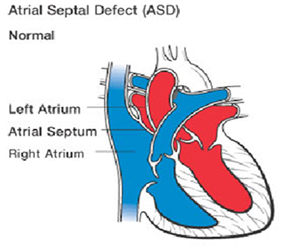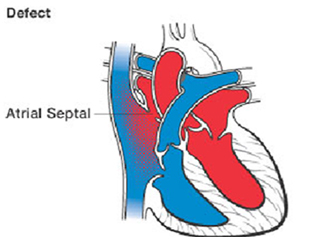What is Atrial Septal Defect (ASD)

An atrial septal defect (ASD) is a hole in the wall between the two upper chambers of your heart. The condition is present from birth (congenital). Smaller atrial septal defects may close on their own during infancy or early childhood.
Large and long-standing atrial septal defects can damage your heart and lungs. An adult who has had an undetected atrial septal defect for decades may have a shortened life span from heart failure or high blood pressure in the lungs. Surgery is usually necessary to repair atrial septal defects to prevent complications.
Symptoms of Atrial Septal Defect (ASD)
Many babies born with atrial septal defects don't have signs or symptoms. In adults, signs or symptoms may not develop until age 30 or later.
Your doctor may first uncover an atrial septal defect during a regular checkup while listening to your heart using a stethoscope. Hearing a heart murmur may signal a hole in your heart. Atrial septal defects are often found when an ultrasound exam of the heart (echocardiogram) is done for another reason.
Signs and symptoms of atrial septal defects develop once damage occurs to the heart and lungs. Infants with larger atrial septal defects may have poor appetites and not grow as they should. Adults and infants may have signs of heart failure or arrhythmias.
Signs and symptoms of large or long-standing atrial septal defects may include : -
- Shortness of breath
- Fatigue
- Swelling of legs, feet or abdomen
- Heart palpitations or skipped beats
Causes of Atrial Septal Defect (ASD)

Doctors know that heart defects present at birth (congenital) arise from errors early in the heart's development, but there's often no clear cause. Genetics and environmental factors may play a role.
An atrial septal defect allows freshly oxygenated blood to flow from the left upper chamber of the heart (left atrium) into the right upper chamber of the heart (right atrium). There it mixes with deoxygenated blood and is pumped to the lungs, even though it's already refreshed with oxygen. If the atrial septal defect is large, this extra blood volume can overfill the lungs and overwork the heart. If not treated, the right side of the heart eventually enlarges and weakens. In some cases, the blood pressure in your lungs increases as well, leading to pulmonary hypertension.
Comparing ASD with patent foramen ovale
The term "atrial septal defect" usually refers to holes in the atria resulting from a lack of atrial septal tissue, rather than those related to a condition called patent foramen ovale (PFO).
Patent foramen ovale occurs when part of the normal fetal heart circulation fails to close properly at birth. During fetal heart development, a channel (the foramen ovale) is present between the atria to allow blood to bypass the lungs. At birth, once the lungs take over breathing, the hole normally closes. In about one in three people, this opening doesn't close.
Treatments and drugs for Atrial Septal Defect (ASD) in India
If your child has an atrial septal defect, your doctor may recommend monitoring it for a period of time to see if it closes on its own, while treating any symptoms with medications.
According to the National Institutes of Health, about half of all atrial septal defects eventually close on their own. About 20 percent close within the first year of life. If a hole hasn't closed early in childhood, it usually won't close on its own. Some small atrial septal defects don't cause any problems and may not need closure, but many require surgery to be corrected. If your child needs treatment, the timing of it depends on your child's condition and whether your child has any other congenital heart defects.
Surgery of Atrial Septal Defect (ASD) in India
Many doctors recommend repairing an atrial septal defect diagnosed during childhood to prevent complications as an adult. For adults and children, surgery involves plugging or patching the abnormal opening between the atria.
Doctors can do this through two methods : -
- Cardiac catheterization : - ASD Closure. A thin tube (catheter) is inserted into a blood vessel in the groin and guided to the heart. Through the catheter, a mesh patch or plug is put into place to close the hole. The heart tissue grows around the mesh, permanently sealing the hole.
- Open-heart surgery : - This type of surgery is done under general anesthesia and requires the use of a heart-lung machine. Through an incision in the chest, surgeons use patches or stitches to close the hole.
Follow-up care depends on the type of defect and whether other defects are present. For simple atrial septal defects closed during childhood, only occasional follow-up care is needed. For adults, follow-up care may depend on any resulting complications.
Thanks for sharing this post. We have noted the details and book marked the blog. If anyone need requirement in Delhi, We'll definitely suggest Best Cardiologist in Delhi. Well-known heart specialists in Delhi with primary area of interest in Electrocardiography. Contact with Best Cardiologist in India. Contact Jiyo India at +91 8750033334, +91 121 4333433
ReplyDelete